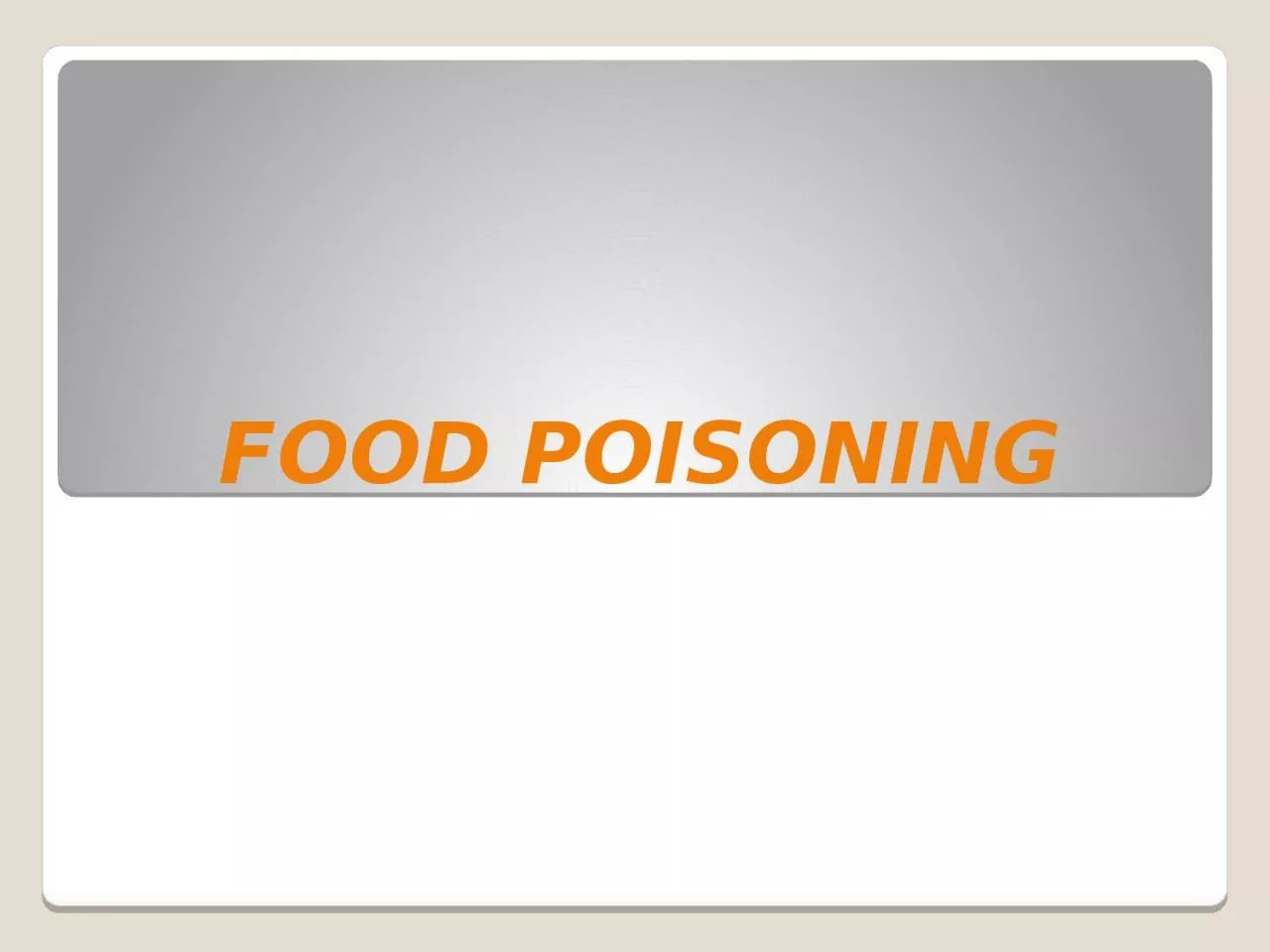

Food poisoning is referred to an illness acquired through consumption of food or drink contaminated with microorganisms or their toxins The term bacterial food poisoning is restricted to acute gastroenteritis due to the presence of bacteria or their toxins in food ID: 1038993
Download Presentation The PPT/PDF document "FOOD POISONING INTRODUCTION" is the property of its rightful owner. Permission is granted to download and print the materials on this web site for personal, non-commercial use only, and to display it on your personal computer provided you do not modify the materials and that you retain all copyright notices contained in the materials. By downloading content from our website, you accept the terms of this agreement.
1. FOOD POISONING
2. INTRODUCTIONFood poisoning is referred to an illness acquired through consumption of food or drink contaminated with microorganisms or their toxins.The term bacterial food poisoning is restricted to acute gastroenteritis due to the presence of bacteria or their toxins in food.It usually results in an outbreak after consumption of food from a common source.Sometimes food poisoning may be due to non-bacterial causes such as chemical poison and poisonous mushrooms.
3. CLASSIFICATIONFood poisoning can be classified into:Infective typeToxic typeIntermediate type1. Infective typeInfective doses of microorganisms are ingested with food.Multiplication of bacteria occurs in-vivo.The typical example is food poisoning by non-typhoidal salmonellae.Incubation period is generally 8-24 hours.
4. 2. TOXIC TYPEPreformed bacterial toxin is ingested with food, as in staphylococcal food poisoning.Incubation period is short (1 to 6 hours).2. INTERMEDIATE TYPEBacteria ingested with food release the toxin in the gut.The typical example is Clostridium perfringens food poisoning.The incubation period is 6 to 12 hours.
5. PREDISPOSING FACTORSImproper storageInadequate cookingEating raw vegetables and foodFood cooked by carriers or infected personsETIOLOGYCausative agents of food poisoning are shown in Table
6. TYPEINCUBATION PERIODCAUSATIVE AGENT1.Infective type8 to 24 hours Non-typhoidal salmonella(S. Typhimurium,S. Enteritidis,S. Newport,S. Thompson,S. Indiana)Vibrio parahaemolyticusCampylobacter jejuni2.Toxic type1 to 6 hoursStaphylococcus aureusBacillus cereus (emetic type)Clostridium botulinum3.Intermediate type6 to 12 hoursClostridium perfringensBacillus cereus(diarrhoeal type)
7. PATHOGENESISSources of infection includes different type of foods which may be vegetables, salads, poultry, eggs, fish, meat, sea food, fried rice, raw milk, milk products, cereals, canned food etc.The infection occurs by consumption of food which is contaminated with bacteria or their toxins.The pathogenic mechanisms include:Invasion of gastrointestinal tract with bacteria e.g. Non-typhoidal Salmonella, Vibrio parahaemolyticus and Compylobacter jejuni.
8. These are infective type. These bacteria include diarrhoea.2. Ingestion of preformed toxin in foods e.g. Staphylococcus aureus and Bacillus cereus which form toxins in food even before consumption. Such food induces vomiting and diarrhoea.These are toxic type.3.ingestion of bacteria in food but toxin production occurs in gut after ingestion e.g. Clostridium perfringens which includes diarrhoea.
9. CAUSATIVE AGENTSOURCE OF INFECTION1.Non-typhoidal salmonellaMilk, eggs, poultry, meat2.Vibrio parahaemolyticusSeafood 3.Compylobacter jejuniRaw milk, poultry, contaminated water4.Staphylococcus aureusMilk, milk products, cream, meat5.Bacillus cereusFried rice from Chinese restaurants, vegetables, meat, cereals6.Clostridium botulinumCanned food7.Clostridium perfringensMeat,poultryCausative agents and their source of infection
10. CLINICAL FEATURESThe incubation period varies according to type of food poisoning (1 to 24 hours) as mentioned earlier.Food poisoning is characterised by:Nausea and vomitingDiarrhoeaAbdominal crampsFeverBacillus cereus food poisoning may present as toxic type or intermediate type.Vomiting is rarely present in Clostridium perfringens and Bacillus cereus intermediate type infections but abdominal cramps may be present. Diarrhoea may be characteristic of all types of food poisoning.
11. LABORATORY DIAGNOSISA. DETAILED HISTORYDetailed history of food consumed and sequence of occurrence of clinical symptoms with their duration should be taken.Number of persons affected by food poisoning is also important.These all would give clue to the etiological agent.B. COLLECTION OF SPECIMENThe following specimens may be collected.StoolSuspected food specimenIn case of death, intestinal contents, liver, spleen and heart blood may be collected.Vomitus is less useful.
12. C. CULTUREDemonstration of causative agent can be done in stool specimen and the food consumed.According to suspected causative agent, culture of stool is done on blood agar, MacConkey agar and selective media.These culture media are incubated at 37°C for 24 to 48 hours.Selective media are used for B. cereus, Campylobacter jejuni and Vibrio parahaemolyticus.Selective media such as MYPA (mannitol egg yolk, polymyxin B, phenol red and agar) is used for B. cereus.Clostridium perfringens and Cl. Botulinum are cultured under anaerobic condition.
13. D. IDENTIFICATIONIdentification of causative agent is based on colony morphology on culture media, Gram staining, biochemical tests and other tests.E. DETECTION OF ENTEROTOXINEnterotoxin in faeces can be detected by ELISA or latex agglutination test.F. MOLECULAR METHODPolymerase chain reaction (PCR) can be used for detection of genes coding for enterotoxins.G. CARRIER DETECTIONRepeated culture of stool and other specimens from suspected carrier is useful to trace the source of infection.
14. PROPHYLAXISTo prevent the occurance of food poisoning the only method is to be strict in cleanliness at all levels of preparation, storage and serving of food.
15. REFERENCE BOOKSTextbook of Microbiology by Ananthanarayan and Paniker’s.Textbook of Microbiology by D. R. Arora and Brij Bala Arora.Textbook of Microbiology by Dr. C. P. Baveja.